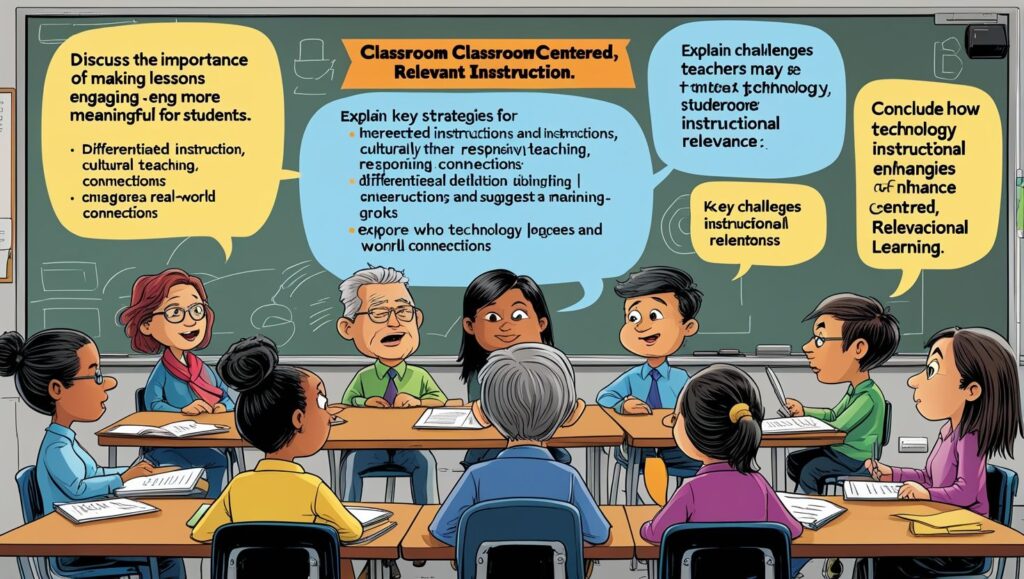Introduction
Classroom Relevant Instructions in Education, Education is a dynamic field that continuously evolves to meet the needs of diverse learners. One of the most critical aspects of effective teaching is the delivery of classroom-relevant instructions. These are teaching strategies, methods, and content that are directly applicable to students’ learning needs, cultural backgrounds, and real-life experiences.
Classroom-relevant instructions ensure that learning is meaningful, engaging, and effective. Teachers must adapt their instructional techniques to align with students’ cognitive abilities, interests, and socio-cultural contexts. This article explores the importance of classroom-relevant instructions, key strategies for implementation, challenges, and the role of technology in enhancing instructional relevance.
The Importance of Classroom-Relevant Instructions
1. Enhances Student Engagement
When instructions are relevant to students’ lives, they are more likely to be engaged. Lessons that connect to real-world applications or students’ personal experiences make learning more interesting and motivating.
2. Improves Learning Outcomes
Relevant instructions help students understand and retain information better. When content is relatable, students can make connections between new knowledge and prior experiences, leading to deeper comprehension.
3. Promotes Inclusive Education
Every classroom consists of students from diverse backgrounds. Classroom-relevant instructions consider cultural, linguistic, and socio-economic differences, ensuring that all students feel represented and valued.
4. Encourages Critical Thinking and Problem-Solving
When lessons are relevant, students are more likely to apply their knowledge to real-life situations. This fosters critical thinking, creativity, and problem-solving skills.
Strategies for Implementing Classroom-Relevant Instructions
1. Differentiated Instruction
Differentiated instruction tailors teaching methods to meet individual learning needs. Teachers can modify:
- Content (what students learn)
- Process (how students learn)
- Product (how students demonstrate learning)
- Learning Environment (classroom setup and resources)
For example, in a mixed-ability classroom, a teacher may provide different reading materials at varying difficulty levels or offer multiple ways to complete an assignment (written, oral, or visual presentations).
2. Culturally Responsive Teaching
This approach integrates students’ cultural references into lessons. Strategies include:
- Using examples from students’ communities.
- Incorporating multicultural literature.
- Encouraging students to share their cultural experiences.
For instance, a history teacher discussing civil rights movements can include perspectives from different cultures to make the lesson more inclusive.
3. Real-World Connections
Teachers should link lessons to real-life scenarios. Examples include:
- Using math problems based on budgeting or shopping.
- Discussing current events in social studies.
- Conducting science experiments related to environmental issues.
A science teacher might explain climate change by discussing its impact on local weather patterns, making the lesson more relatable.

4. Student-Centered Learning
This approach shifts the focus from teacher-led instruction to student-driven exploration. Techniques include:
- Project-Based Learning (PBL): Students work on long-term projects that solve real-world problems.
- Inquiry-Based Learning: Students ask questions, research, and present findings.
- Collaborative Learning: Group activities where students learn from peers.
For example, instead of a traditional lecture on ecosystems, students could design a school garden, applying biology concepts in a hands-on manner.
5. Use of Technology
Digital tools can make learning more relevant by:
- Providing interactive simulations (e.g., virtual labs in science).
- Offering personalized learning apps (e.g., Khan Academy, Duolingo).
- Enabling global collaboration (e.g., connecting with students from other countries via video calls).
A geography teacher could use Google Earth to explore different terrains, making abstract concepts more tangible.
Challenges in Implementing Classroom-Relevant Instructions
Despite its benefits, teachers may face obstacles in delivering relevant instructions:
1. Standardized Curriculum Restrictions
Many schools follow rigid curricula that leave little room for customization. Teachers may struggle to incorporate relevant examples if they must strictly adhere to textbooks.
2. Diverse Student Needs
With varying learning styles, abilities, and backgrounds, it can be challenging to design lessons that cater to every student.
3. Lack of Resources
Schools in underfunded areas may lack materials, technology, or professional development opportunities for teachers to implement innovative strategies.
4. Resistance to Change
Some educators may be hesitant to move away from traditional teaching methods due to familiarity or administrative pressure.

Overcoming the Challenges
1. Professional Development
Schools should provide training on differentiated instruction, culturally responsive teaching, and technology integration.
2. Flexible Curriculum Design
Policymakers should allow modifications in curricula to include local and student-centered content.
3. Community and Parental Involvement
Engaging families and community members can provide insights into students’ backgrounds, helping teachers design more relevant lessons.
4. Leveraging Open Educational Resources (OER)
Free online resources can help teachers access diverse materials without financial constraints.
The Role of Technology in Enhancing Instructional Relevance
Technology has revolutionized education by making learning more interactive and personalized. Key contributions include:
1. Adaptive Learning Platforms
Tools like DreamBox (for math) and Lexia (for literacy) adjust difficulty levels based on student performance.
2. Gamification
Educational games (e.g., Prodigy Math, Kahoot!) make learning fun and relevant by incorporating challenges and rewards.
3. Virtual and Augmented Reality (VR/AR)
These technologies provide immersive experiences, such as virtual field trips or 3D science models, making abstract concepts tangible.
4. AI-Powered Tutoring
AI chatbots (e.g., ChatGPT for education) can provide instant explanations and personalized study plans.
Conclusion
Classroom-relevant instructions are essential for meaningful and effective learning. By incorporating differentiated instruction, culturally responsive teaching, real-world applications, and technology, educators can create engaging and inclusive learning environments.
While challenges exist, professional development, flexible curricula, and community involvement can help overcome them. As education continues to evolve, teachers must remain adaptable, ensuring that their instructions resonate with every student’s needs and experiences. By prioritizing relevance in teaching, we can foster a generation of critical thinkers, problem-solvers, and lifelong learners prepared for the complexities of the modern world.

6 thoughts on “Classroom Relevant Instructions in Education”